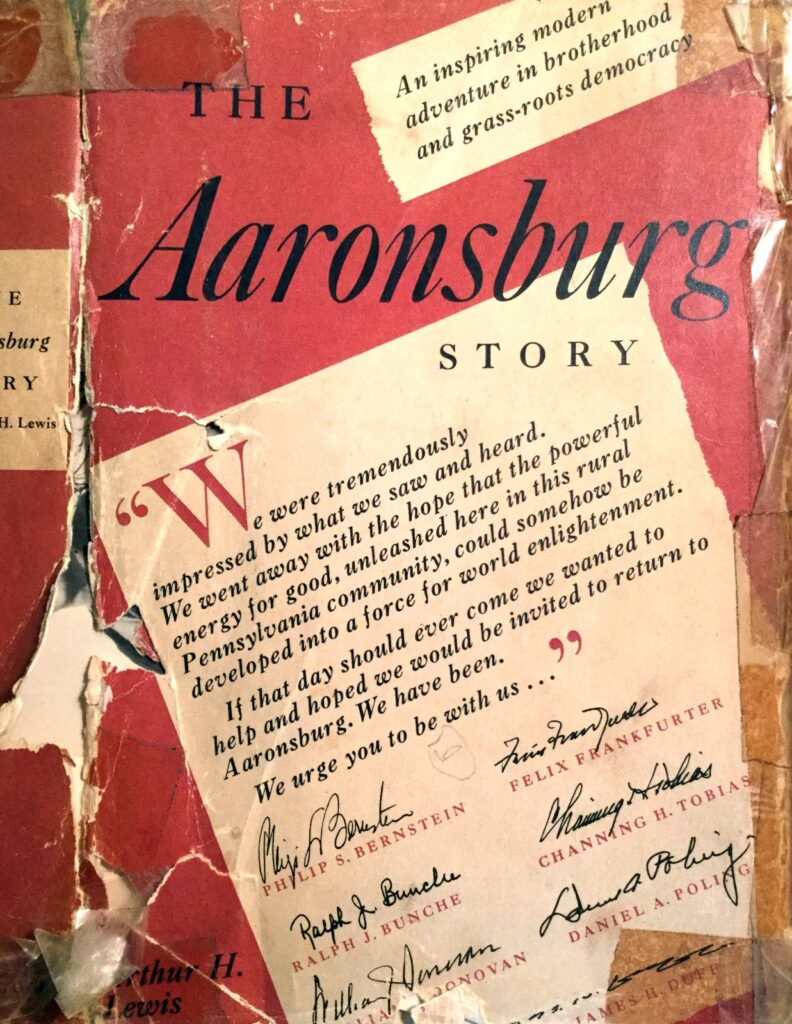“The Aaronsburg Story,” held on October 23, 1949, was a pageant and panel in Aaronsburg that garnered worldwide attention and later a book. The event, which commemorated the community’s origin and founder, Aaron Levy, was a hallmark of the post-World War II years for rural Centre County residents with a message that people of all backgrounds should be willing to accept one another and work together, despite their differences.
The pageant took place in the aftermath of World War II, when people were beginning to grasp the war’s larger meaning, learning from the horrors that took place and considering implications for the future. The event served as a discussion of common goals of humanity with an eye to remaining vigilant about the threat of totalitarianism throughout the world and preventing future wars. Participants also discussed principles that carried forward to many causes in the future connected with racial and religious equality, including the civil rights movement in the United States.

Arthur H. Lewis, a former journalist who was serving as a publicity aide to Governor James H. Duff, was traveling to Pittsburgh in 1949 when he drove by a plaque beside State Route 45 in Aaronsburg that said: “Aaronsburg, named for Aaron Levy. Founded 1786.” Lewis asked residents of the town about its origins and he came to admire both the founder and the generations of Aaronsburg residents. In 1786, Levy, a Jewish immigrant from the Netherlands, donated land on which to build a Christian church and school for what is now Aaronsburg.
After getting approval from Duff, Lewis enlisted the help of Centre County residents and people from around the world as he organized the project. The goal was to share the legacy of Levy’s generosity in an effort to spread the message that rural Americans were tolerant and grateful for the chance to interact with people who are different from themselves. This was contrary to what Lewis said was a common belief that rural citizens often were closed-minded.
The 1949 pageant entitled, “The Issue of an Ideal,” was a re-enactment of the story of Levy’s generosity. A member of the Jewish faith, Levy gave land to a community of German Protestant immigrants to build Salem Evangelical Lutheran Church. Although it was typical of the time for real estate developers to set aside land for religious institutions and schools, the donation was viewed as a symbol of goodwill because it was made despite differences in the religious beliefs of the giver and receiver.
Speakers at the pageant including Duff, United Nations Mediator Ralph J. Bunche, Major-General William J. Donovan, Supreme Court Justice Felix Frankfurter, and NAACP activist Channing H. Tobias. Local participants included Salem Evangelical Lutheran Church member Alfred E. Mingle and the church’s pastor, the Rev. James S. Shannon. Cornel Wilde, a well-known film actor, narrated the performance. The Penn State Blue Band and the State College High School Choir performed.
An estimated 30,000 people attended the pageant. Major news organizations covered the event and there was a live radio transmission. The day after the pageant, the New York Times published news stories and an editorial praising the event for promoting a “good and ancient cause,” stating of the participants: “… they addressed themselves to what had been done to remove prejudice, to guard the rights of minorities, and to strengthen democracy.”
In the early 1950s, follow-up assemblies took place with Aaronsburg residents and well-known national and international leaders participating. Lewis wrote a book, The Aaronsburg Story, that was published in 1955.
Sally Heffentreyer
Sources:
“Aaronsburg Story,” Special Collection, University Libraries, Penn State.
Fish, Sidney M. Aaron Levy: Founder of Aaronsburg. New York: American Jewish Historical Society, 1951.
Lewis, Arthur H. The Aaronsburg Story. New York: Vanguard Press, 1955.
Hon. Abraham J. Multer of New York, “A Message on Tolerance from Our Colonial History.” Remarks in the House of Representatives, Appendix to the Congressional Record, January 12, 1950, p. A193.
“30,000 Attend Aaronsburg Rites,” Centre Democrat, October 27, 1949.
First Published: August 11, 2021
Last Modified: June 10, 2024
